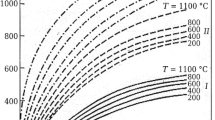Abstract
To extend the service life of refractory linings in high-temperature furnaces, it is becoming common to embed copper cooling devices in the lining. These devices extract enough heat from the hearth of the furnace to freeze a protective thin layer of slag onto the surface of the lining. However, the cooling devices may lose their efficiency over time. It is believed that high-temperature oxidation of copper is responsible for the loss in heat-extraction capacity. To test coolers under severe conditions, immersion tests were carried out in molten matte and slag of laboratory-scale cooling elements protected by various means. A composite cooler was developed that consists of a copper core shielded by a Cu-4 wt.% Al alloy sheet. Although the rate of heat extraction is not as high as that of the un-alloyed copper, this cooler still extracts heat at a very high rate.
Similar content being viewed by others
References
A.R. Legget and N.B. Gray, “Development and Application of Novel Refractory Cooling System,” Proc. Advances in Refractories for the Metallurgical Industries II, ed. M. Rigaud and C. Allaire (Montréal, QC, Canada: CIM, 1996), p. 519.
G.G. Hatch and B.O. Wasmund, “Cooling Devices for Protecting Refractory Linings of Furnaces,” U.S. patent 3,849,587 (19 November 1974).
J. Merry, J. Sarvinis, and N. Voermann, “Designing Modern Furnace Cooling Systems,” JOM, 52 (2) (2000), p. 62.
R. Bergman, private communication (University of Toronto, Toronto, Canada, 2001).
G. Plascencia (Ph.D. thesis, University of Toronto, Toronto, Canada, 2004).
U.V. Aniekwe (M.A.Sc. thesis, University of Toronto, Toronto, Canada, 2000).
U.V. Aniekwe and T.A. Utigard, “High Temperature Oxidation of Nickel Plated Copper vs Pure Copper,” Can. Met. Quarterly, 38 (4) (1999), p. 277.
Y.S. Touloukian and C.Y. Ho, editors, Thermophysical Properties of Matter, Vol 1, Thermal Conductivity of Metals and Alloys (New York: Plenum Press, 1970), p. 470.
K. Ho and R.D. Phelke, “Metal-Mould Interfacial Heat Transfer,” Metal. Trans. B, 16B (1985), p. 585.
Author information
Authors and Affiliations
Additional information
For more information, contact Gabriel Plascencia, CIITEC-IPN, Cerrada Cecati s/n, C.P. 02250, Mexico, D.F.; e-mail g.plascencia@utoronto.ca.
Rights and permissions
About this article
Cite this article
Plascencia, G., Utigard, T.A., Plascencia, G. et al. Extending the life of water-cooled copper cooling fingers for furnace refractories. JOM 57, 44–48 (2005). https://doi.org/10.1007/s11837-005-0150-x
Issue Date:
DOI: https://doi.org/10.1007/s11837-005-0150-x




